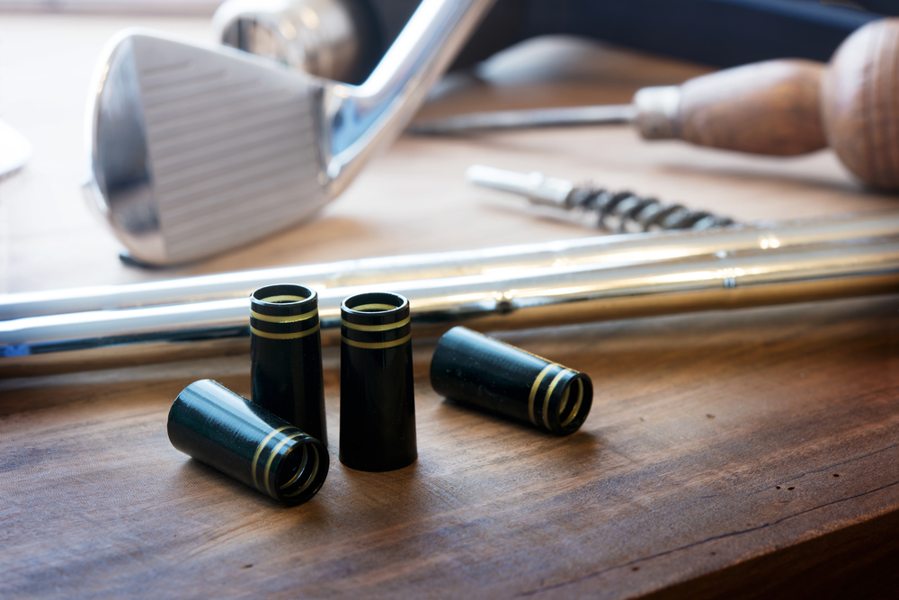How to Pick The Right Golf Shaft
Whether you are repairing your broken golf club or buying a new golf club, there are a few things you should know before choosing a golf shaft. The first thing is to decide is what type of golf shafts you would prefer, followed by shaft flex, kick-point, torque rating and length. Each of these different aspects of golf club shafts that can influence the performance of your club, and each must be carefully considered before you put in an order. Read on to find out all about how to pick the right golf shaft for you in this guide.
Here’s how to choose the right golf shaft
Photo credit: optimarc / Shutterstock
Types of golf shafts
There are two basic types of golf shafts: steel and graphite. Often, your club will have been originally assembled with either of these types of shafts, however if you decide that you would like to change your type of shaft, you should know the difference between each shaft type. There are some newer options that combine the two materials, known as multi-material shafts.
- Steel shafts
Steel shafts are much heavier, more durable and are generally less expensive than their graphite counterparts. They are often made from carbon steel, but stainless steel is sometimes used, and start at 120 grams.
Many players will benefit from having steel irons as torque or lateral twisting found in all graphite shafts doesn’t occur in steel. Therefore, steel shafts offer more control and have greater emphasis on accuracy than distance, which means that a faster swing speed is required to generate the same distance as a graphite shaft.
Steel shafts are recommended for players with normal swing speeds, who could do with more control when playing.
- Graphite shafts
Graphite shafts are much lighter, less durable and more expensive in comparison to steel shafts, and weigh between 50 and 85 grams – around half the weight of a steel shaft! These light-weight shafts help to provide a greater swing speed for more power, however, it sacrifices control due to the flex generated in the swing.
As a result, graphite shafts are a good choice for all golfers. In particular, they are suited to women golfers and seniors, who may struggle to produce a fast-enough swing speed to use a steel shaft effectively.
This shaft type often comes with an extensive range, including a variation in flexes and colours, which appeals to amateurs and professionals alike.
- Multi-material shafts
A recent addition to the market are multi-material shafts which are used on both irons and drivers. This type of shaft incorporates steel and graphite into one shaft to get the best of both worlds for each player, to suit all playing types.
Generally, the shaft is made using a steel shaft that has a graphite tip. The steel shaft allows the player to control the ball flight more, whilst the graphite tip ensures the golf ball can go the distance without any unwanted vibrations.

RELATED: Quick Golf Club Size Guide for Beginners
Shaft technology
- What golf shaft flex is right for me?
Put simply, the flex determines a golf club shaft’s ability to bend during a swing, affecting the distance and direction. Therefore, getting the right flex in your golf clubs is important.
Which flex rating you use will depend on the type of swing you have. For example, beginners and those with less powerful swings tend to use a shaft with greater flexibility to propel the ball more. On the other hand, if a player has a high and powerful swing speed, they will require a stiffer shaft with less flex.
There are a range of different types of flex ratings:
- Extra stiff (XS)
- Stiff (S)
- Firm (F)
- Regular (R)
- Senior (S)
- Amateur (A)
- Ladies (L)
It is worth bearing in mind that different shaft manufacturers vary in their specifications of flex – for example, one manufacturer’s “regular flex” might be another’s “firm flex”. Furthermore, all shafts, no matter how stiff, exhibit flex in one way or another.
- Golf Shaft Flex Chart
Even though getting fitted for a specific shaft is the best way to find the right shaft, this chart will give you some general guidelines that can help get you started in the right place:
| Carry Distance | Swing Speed | Flex |
| Under 200 yards | Under 75 mph | Ladies or Senior |
| 200 to 240 yards | 75 to 95 mph | Regular |
| 240 to 275 yards | 95 to 110 mph | Stiff |
| Over 275 yards | Over 110 mph | Stiff or Extra Stiff |
RELATED: Do I Need Custom Fitted Golf Clubs?
- What is the kick point on a golf shaft?
The shaft kick-point – also known as flex-point – is the point where the shaft bends and affects the trajectory of the shot. Although the effect is only small, it is still measurable.
For clarity, a shaft with a high kick-point will often give a low shot trajectory and create the feel of a “one-piece”. On the other hand, a low kick-point will usually give a high shot trajectory and a feeling of the shaft tip whipping the clubhead through.
- What is shaft torque?
Every shaft has a torque rating, which is measured in degrees, in order to determine how much the shaft will twist during a swing. Put simply, the higher the rating, the more the shaft is prone to twisting.
It is the torque that also determines how the shaft feels to every player, which means that the higher the rating, the softer the shaft will feel. A shaft with a 3-degree torque will feel much stiffer than a 5-degree torque, for example.
Every shaft – whether it be graphite or steel – has a certain amount of torque. You won’t be able to get rid of torque completely, but it is worth remembering that the lower the torque, the lower the trajectory will be.

Golf club shaft length
Once the shaft is installed onto your golf club, you must determine the right length for you. But how important is shaft length, we hear you say? Well, the importance of length, according to research, is extreme. For instance, ball impact that is 0.5 inches off-centre equates to a 7% loss of carry distance, and an impact that is 1 inch off-centre equates to a 14% loss of carry distance. So, the key to choosing the right shaft is finding the correct length that provides a repeating, solid hit each time.
- How to measure the length of a golf club shaft?
In order to determine the length of your club, stand tall and get someone to measure from the crease where your wrist and hand meet to the floor. Do this with both hands and take an average of the two measurements.
The following lists what length of shafts you should consider for certain heights. If the crease where your wrist and hand meet to the floor is:
- 29 to 32 inches = irons should be based on a 5-iron of 37 inches
- 33 to 34 inches = irons should be based on a 5-iron of 37 1/2 inches
- 35 to 36 inches = irons should be based on a 5-iron of 38 inches
- 37 to 38 inches = irons should be based on a 5-iron of 38 1/2 inches
- 39 to 40 inches = irons should be based on a 5-iron of 39 inches
- 41 or more inches = irons should be based on a 5-iron of 39 1/2 inches
How to know if you have picked the wrong shaft?
If you have picked the wrong shaft, you will immediately know. When you go to swing the club, you will find that the ball won’t go as far as it should, and you may hit the ball off-centre. You may also find that the club may feel “dead” if the shaft is too heavy or stiff, or alternatively it can feel too soft and weak – both can significantly impact your game. Therefore, if you don’t know what to do, don’t guess, because you may end up with the wrong shaft for you and it can be costly to rectify if you have to buy more shafts or new golf equipment.
If you don’t know, don't guess – get custom fitted
Custom fitting – which was once reserved only for Tour players and the best amateurs – is now available to any golfer who's willing to spend the time and money to get a properly fitted set of clubs.
With today’s technology and vast number of products to examine, an experienced club fitter can help anyone find the right club shaft for their golf club. Custom fitting can be done with woods, irons, wedges and even putters from most manufacturers, and professional fitters will work with you to decide the custom fit lie angles, face angles, lofts, lengths, swing weights and other options.
Custom fitting may well increase the cost of your set of clubs, but the benefits in terms of performance (and not changing clubs so often) are definitely worth the extra money. This is seen by our team in this YouTube video, demonstrating with a golf driver:
Get in touch with our PGA professional fitter today on 0844 324 6766, or talk to a member of staff in store, to book a custom fitting.
Feature image credit: optimarc / Shutterstock
















